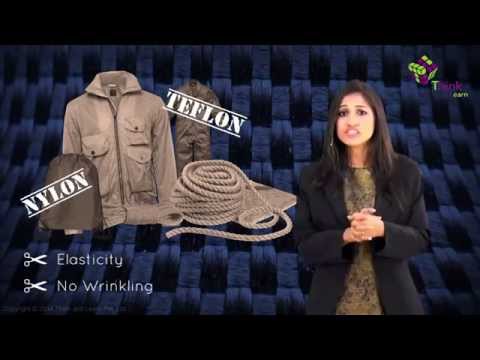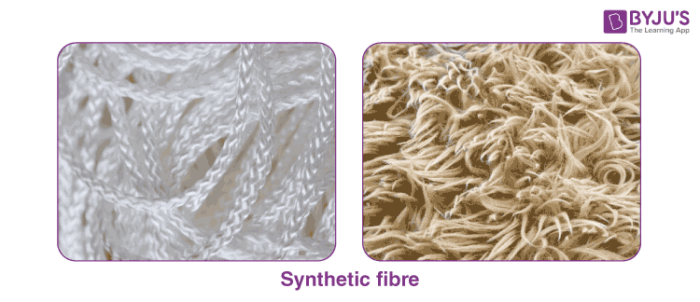What is Synthetic Fibre?
Synthetic fibres are made only from polymers found in natural gas and the by-products of petroleum.
Synthetic fibres are man-made fibres, most of them are prepared from raw material petroleum called petrochemicals. All fabrics are obtained from fibres, while fibres are obtained from artificial or man-made sources. They consist of a small unit or a polymer which is made from many repeating units known as monomers. They include nylon, acrylics, polyurethane, and polypropylene. Millions of tons of these fibres are produced all over the world each year.
Table of Contents
- Recommended Videos
- Classification of Synthetic Fibers
- Synthetic Fibres Examples
- Advantages of Synthetic Fibres
- Disadvantages of Synthetic Fibres
- Frequently Asked Questions – FAQs
Recommended Videos

Classification of Synthetic Fibres
Following are some of the most commonly used synthetic fibres: Know more about Classifications of Fibers

1. Rayon
- This is a type of synthetic fibre obtained from wood pulp.
- Rayon fabric is soft, absorbent and comfortable.
- It is easy to dye in a wide range of colours.
- Rayon is mixed with cotton to make bedsheets.
- Rayon is mixed with wool to make carpets.
2. Nylon
- This type of synthetic fibre is obtained from coal, water and air.
- Nylon is very lustrous, easy to wash and elastic.
- It dries quickly and retains its shape.
- Nylon finds its application in seat belts of car, sleeping bags, socks, ropes, etc.
- Nylon is also used in ropes for rock climbing, making parachutes and fishing nets.
3. Polyester
- This type of synthetic fibre is obtained from coal, water, air and petroleum.
- Polyester is made from repeating units of a chemical known as esters.
- Polyester is easy to wash and it remains wrinkle-free and it is quite suitable in making dress material.
- Polyester retains its shape and remains crisp.
- Polyester is used in making ropes, nets, raincoats, jackets, etc.
Synthetic Fibres Examples
The modern textile industry is unthinkable today without synthetic fibres. Man-made fibres like silk have always been greatly valued for its gloss and fineness. Man-made fibres are smooth. They can be distinguished by looking at a cross-section. Some synthetic fibres are listed below.
- rayon
- nylon
- polyester
This fibre finds its applications in household articles like ropes, bucket, furniture, etc.
Advantages of Synthetic Fibres
- Synthetic fibres are very durable and do not wrinkle easily
- They are elastic and can be easily stretched out
- They are strong and can sustain the heavy load.
- They are soft and hence used in clothing material.
- They are cheaper than compared to natural fibres.
Disadvantages of Synthetic Fibres
- Most synthetic fibres do not absorb moisture.
- Synthetic fibre can be affected if washed using hot water.
- They catch fire easily as compared to natural fibre.
Frequently Asked Questions – FAQs
How synthetic Fibres are made?
Synthetic fibers are made from small molecules synthesized polymers. The substances used to produce such fibres are extracted from raw materials such as chemicals based on petroleum or petrochemicals. Such materials are polymerized into a chemical that ties together two adjacent atoms of carbon.
What are the uses of synthetic Fibres?
It is used in the manufacture of ropes, nets for fishing and seat belts. Polyester – This fabric is made from coal and oil and is wrinkle-free and easy to clean. It is used for the production of caps, raincoats, and ropes.
What are the disadvantages of synthetic Fibres?
Like natural fibres, synthetic fibres do not easily take up colours. These fibres can burn faster than natural fibres. They are prone to damage to heat and easily melt.
What are the types of synthetic Fibre?
For example, man-made synthetic fibres such as rayon, nylon, acrylic, etc. A Synthetic Fiber is a string of a combination of small units of chemical substance.
What is the characteristic of synthetic Fibre?
Synthetic fibres are more durable: they have bright wear and tear resistance. Because of this, synthetic fibre fabric is very durable. Such fibres have a high lustre, and with age, they don’t turn yellow.
To follow more about synthetic fibre, download BYJU’S – The Learning App.
Read more:


Byjus is the best way to learn
Byju’s is awesome. it makes learning fun.
Byju’s is awesome it provides us the free app and another website also where we can search for information nice ?